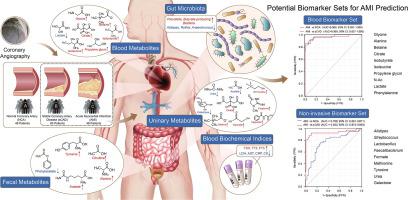Journal of Advanced Research ( IF 10.7 ) Pub Date : 2022-06-21 , DOI: 10.1016/j.jare.2022.06.008 Chaoran Dong 1 , Yanan Yang 2 , Yinghong Wang 1 , Xiaomin Hu 3 , Qingchun Wang 1 , Feng Gao 1 , Shanshan Sun 1 , Qifeng Liu 1 , Lei Li 4 , Jianxun Liu 4 , Yida Tang 5 , Shuyang Zhang 3 , Chongming Wu 6 , Haibo Zhu 1

|
Introduction
Acute myocardial infarction (AMI) accounts for the majority of deaths caused by coronary artery disease (CAD). Early warning of AMI, especially for patients with stable coronary artery disease (sCAD), is urgently needed. Our previous study showed that alterations in the gut microbiota were correlated with CAD severity.
Objectives
Herein, we tried to discover accurate and convenient biomarkers for AMI by combination of gut microbiota and fecal/blood/urinary metabolomics.
Methods
We recruited 190 volunteers including 93 sCAD patients, 49 AMI patients, and 48 subjects with normal coronary artery (NCA), and measured their blood biochemical parameters, 16S rRNA-based gut microbiota and NMR-based fecal/blood/urinary metabolites. We further selected 20 subjects from each group and analyzed their gut microbiota by whole-metagenome shotgun sequencing.
Results
Multi-omic analyses revealed that AMI patients exhibited specific changes in gut microbiota and serum/urinary/fecal metabolites as compared to subjects with sCAD or NCA. Fourteen bacterial genera and 30 metabolites (11 in feces, 10 in blood, 9 in urine) were closely related to AMI phenotypes and could accurately distinguish AMI patients from sCAD patients. Some species belonging to Alistipes, Streptococcus, Ruminococcus, Lactobacillus and Faecalibacterium were effective to distinguish AMI from sCAD and their predictive ability was confirmed in an independent cohort of CAD patients. We further selected nine indicators including 4 bacterial genera, 3 fecal and 2 urinary metabolites as a noninvasive biomarker set which can distinguish AMI from sCAD with an AUC of 0.932.
Conclusion
Combination of gut microbiota and fecal/urinary metabolites provided a set of potential useful and noninvasive predictive biomarker for AMI from sCAD.
中文翻译:

肠道菌群结合代谢物揭示了急性心肌梗死患者不同于稳定型冠状动脉疾病的独特特征
介绍
急性心肌梗死 (AMI) 占冠状动脉疾病 (CAD) 引起的死亡的大部分。急需 AMI 的早期预警,尤其是对于稳定型冠状动脉疾病 (sCAD) 患者。我们之前的研究表明,肠道微生物群的改变与 CAD 严重程度相关。
目标
在此,我们试图通过结合肠道微生物群和粪便/血液/尿液代谢组学来发现准确且方便的 AMI 生物标志物。
方法
我们招募了 190 名志愿者,包括 93 名 sCAD 患者、49 名 AMI 患者和 48 名冠状动脉 (NCA) 正常的受试者,并测量了他们的血液生化参数、基于 16S rRNA 的肠道微生物群和基于 NMR 的粪便/血液/尿液代谢物。我们进一步从每组中选择了 20 名受试者,并通过全基因组鸟枪法测序分析了他们的肠道微生物群。
结果
多组学分析显示,与患有 sCAD 或 NCA 的受试者相比,AMI 患者在肠道微生物群和血清/尿液/粪便代谢物方面表现出特定的变化。14 个细菌属和 30 种代谢物(粪便中 11 种,血液中 10 种,尿液中 9 种)与 AMI 表型密切相关,可以准确区分 AMI 患者和 sCAD 患者。一些属于Alistipes , Streptococcus , Ruminococcus , Lactobacillus和Faecalibacterium的物种有效区分 AMI 和 sCAD,并且它们的预测能力在独立的 CAD 患者队列中得到证实。我们进一步选择了 9 个指标,包括 4 个细菌属、3 个粪便和 2 个尿液代谢物作为非侵入性生物标志物集,可以区分 AMI 和 sCAD,AUC 为 0.932。
结论
肠道微生物群和粪便/尿液代谢物的组合为来自 sCAD 的 AMI 提供了一组潜在有用且无创的预测生物标志物。



























 京公网安备 11010802027423号
京公网安备 11010802027423号